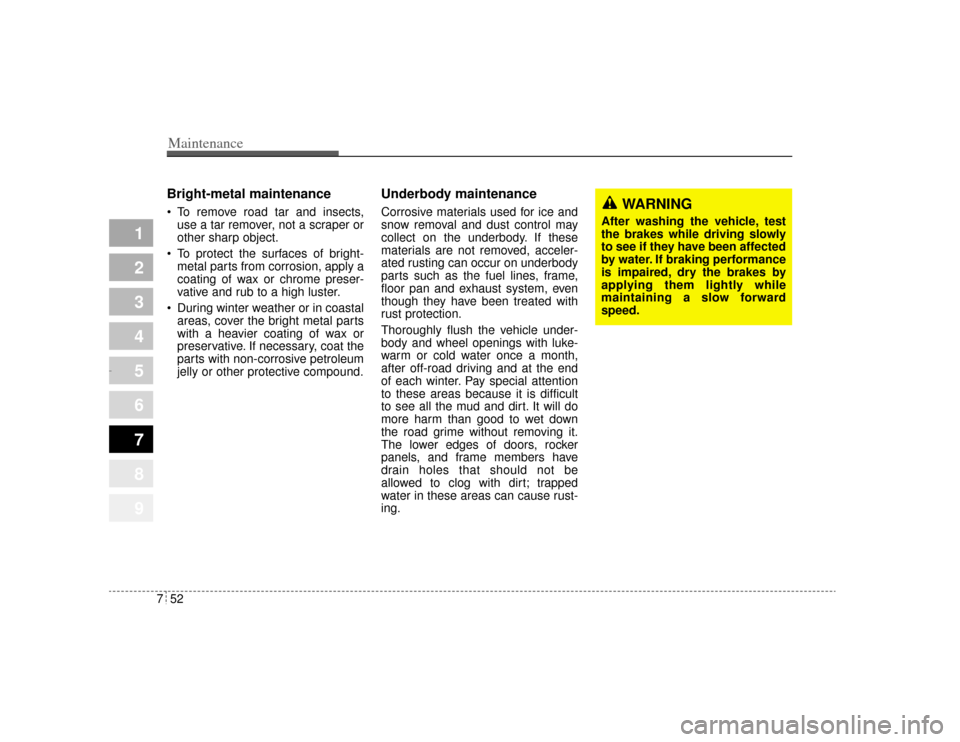Page 286 of 296

749
Maintenance
1
2
3
4
5
6
7
8
9
Recommended SAE viscosity
number ✽ ✽NOTICEAlways be sure to clean the area
around any filler plug, drain plug,
or dipstick before checking or
draining any lubricant. This is espe-
cially important in dusty or sandy
areas and when the vehicle is used
on unpaved roads. Cleaning the plug
and dipstick areas will prevent dirt
and grit from entering the engine
and other mechanisms that could be
damaged. Engine oil viscosity (thickness) has
an effect on fuel economy and cold
weather operating (starting and oil
flow). Lower viscosity engine oils can
provide better fuel economy and cold
weather performance, however,
higher viscosity engine oils are
required for satisfactory lubrication in
hot weather. Using oils of any viscos-
ity other than those recommended
could result in engine damage.
Temperature Range for SAE Viscosity Numbers
Temperature
Engine Oil °
C
( ° F)
-30 -20 -10 0 10 20 30 40 50
-20 0 20 40 60 80 100 120
20W-40, 20W-50
10W-30, 10W-40, 10W-50
5W-30, 5W-40
When choosing an oil, consider the range of temperature your vehicle will be
operated in before the next oil change. Proceed to select the recommended
oil viscosity from the chart.
Opirus CAN 7-1.qxd 7/8/03 2:26 PM Page 49
Page 289 of 296

Maintenance52
7
1
2
3
4
5
6
7
8
9
Bright-metal maintenance To remove road tar and insects,
use a tar remover, not a scraper or
other sharp object.
To protect the surfaces of bright-
metal parts from corrosion, apply a
coating of wax or chrome preser-
vative and rub to a high luster.
During winter weather or in coastal
areas, cover the bright metal parts
with a heavier coating of wax or
preservative. If necessary, coat the
parts with non-corrosive petroleum
jelly or other protective compound.
Underbody maintenanceCorrosive materials used for ice and
snow removal and dust control may
collect on the underbody. If these
materials are not removed, acceler-
ated rusting can occur on underbody
parts such as the fuel lines, frame,
floor pan and exhaust system, even
though they have been treated with
rust protection.
Thoroughly flush the vehicle under-
body and wheel openings with luke-
warm or cold water once a month,
after off-road driving and at the end
of each winter. Pay special attention
to these areas because it is difficult
to see all the mud and dirt. It will do
more harm than good to wet down
the road grime without removing it.
The lower edges of doors, rocker
panels, and frame members have
drain holes that should not be
allowed to clog with dirt; trapped
water in these areas can cause rust-
ing.
WARNING
After washing the vehicle, test
the brakes while driving slowly
to see if they have been affected
by water. If braking performance
is impaired, dry the brakes by
applying them lightly while
maintaining a slow forward
speed.
Opirus CAN 7-1.qxd 7/8/03 2:26 PM Page 52
Page 296 of 296

85
1
2
3
4
5
6
7
8
9
Specifications
Light Bulbs
*1)HID(High Intensity Discharge) type
*2)With sunroof
* This mark indicates the filament is not used Capacities
Light Bulb
Wattage
Headlights (High/Low) 55/55 or 35*
1)
Front turn signal lights (LED type) 13.2
Position lights 5
Side mark lights 5
Front fog lights (if equipped) 55
Stop and tail lights 28/8
Rear turn signal lights 28/8*
Back-up lights 16
High mounted stop light (LED type) 2.54
License plate lights 5
Front map lamp 5 or 10*
2)
Center dome lamp 10
Door courtesy lamps 5
Vanity mirror lamps 3
Trunk room lamp 5
Foot lamp 5
Glove box lamp 5
LubricantVolume Classification
Engine oil
*1
4.3 l(4.5 qt.)
API SERVICE SH or above
Transaxle
8.5 l(9.0 qt.) DIAMOND ATF SP-III,
fluid SK ATF SP-III
Power steering 1.0 l(1.1 qt.) PSF-III
Coolant 10.2
l
Ethylene glycol base for
(10.8 qt.
) aluminum radiator
Brake fluid 0.7~0.8
l
FMVSS116 DOT-3
(
0.7~0.8 qt.
) or DOT-4
Fuel 70
l Unleaded gasoline with
(18.5 gal) AKI 87 or higher
*¹Refer to the recommended SAE viscosity numbers on the page 7-49.
Opirus CAN 8-1.qxd 7/8/03 2:31 PM Page 5